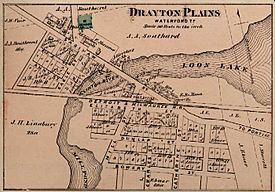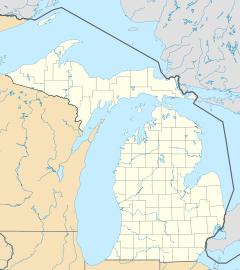Drayton Plains, Michigan facts for kids
Quick facts for kids
Drayton Plains, Michigan
|
|
|---|---|

Map of Drayton Plains in 1872
|
|
| Country | United States |
| State | Michigan |
| County | Oakland |
| Township | Waterford |
| Settled | 1822 |
| Platted | 1860 |
| Elevation | 968 ft (295 m) |
| Time zone | UTC-5 (EST) |
| • Summer (DST) | UTC-4 (EDT) |
| ZIP code(s) |
48329 (Waterford)
|
| Area code(s) | 248 |
| FIPS code | 26-84240 |
| GNIS feature ID | 1627218 |
Drayton Plains is a small community in Oakland County, Michigan, USA. It's not a city or town with its own government. Instead, it's an unincorporated community within Waterford Township. This means it doesn't have its own official borders or population count. Drayton Plains used to have its own ZIP Code, 48020, but now it uses the 48329 ZIP Code, which belongs to Waterford. You can find this community on Dixie Highway, close to the west side of Loon Lake.
Contents
First Settlers Arrive
In 1818, the United States government started selling land in Detroit. Land was available for $2.00 an acre. People like Horatio Foster, Jonathan Perry, and the brothers Harvey and Austin Durfee were some of the first to buy land in the wild areas north of Detroit.
Early Pioneers in Drayton Plains
Horatio Foster and his wife were the first to settle in the area that would become Drayton Plains in 1822. They only stayed for a few years before moving further north. In 1823, Jonathan Perry, Harvey Durfee, and Austin Durfee became the first to build permanent homes here.
Growth and Development
A big change happened in 1825 when the Erie Canal opened. This canal connected Lake Erie in the west to the Hudson River in the east. It made traveling from the eastern states much easier. This led to many more settlers moving into the Michigan Territory.
In 1829, work began on a road north from Detroit, called the Saginaw Trail. This road made it simpler for people to travel into the wilderness.
In 1835, Daniel Windiate moved from England to this area. He built a dam and a mill and named it Drayton, after his hometown in England. He passed away in Drayton Plains in 1843.
Drayton Plains was often called a village, even though it wasn't officially one. It got its own post office on February 4, 1835, located on Mill Street (now Hatchery Road).
In 1837, Michigan officially became the 26th state in the USA. This made even more settlers want to move to the area.
The first burial in Drayton Plains Cemetery happened in 1838. It was for the six-week-old son of Daniel and Martha Windiate. In 1839, Daniel Windiate also built the Drayton Plains Hotel along the Saginaw Trail (now Dixie Highway).
Developing the Community
In 1850, a railroad line was finished through Drayton Plains. A train depot was built in 1908 by the Detroit, Grand Haven and Milwaukee Railway. This railroad helped the population of Waterford Township grow to 1,085 people that year.
Drayton Plains was officially mapped out, or platted, in 1860 by Lewis L. Dunlap. By 1860, Waterford Township's population had reached 1,289. As Drayton Plains grew, more businesses started to open.
Local Businesses and Services
In 1865, John Linabury built the first stable in Drayton Plains. The first cider mill was built in the 1860s by John Kirodot.
By 1872, many businesses were operating in Drayton Plains:
- C.B. Albertson was the first railroad station agent.
- John Ebner was a farmer and raised animals.
- H.D. Judd owned a grist mill.
- A.A. Southard was a general farmer.
- Paul Shwesinger was a merchant who made and sold boots and shoes, and other general goods.
- Moses Southard worked as a blacksmith.
- James Swartz also made and sold boots and shoes, and other items in his store.
William Besley, who was Daniel Windiate's son-in-law, owned a general store. This store was very important. It also served as a post office, a place to vote, a Sunday school, and even a Saturday night dance hall. A tin shop was also located there. People would cut ice from Loon Lake and sell it around the area.
Many streets in Drayton Plains were named after these early settlers, such as Denby, Covert, Frembes, Linabury, Meinrad, Van Syckle, and Van Zandt.
Schools in Drayton Plains
The first school in Drayton Plains was built around 1865. It was a one-room wooden school located at Monroe Street and Sashabaw Road. This school was used until 1920, when a new Drayton Plains School was built at the same spot. The first teacher was Lewis M. Covert. Today, this old school building has been moved to The Pine Grove Historical Museum in Pontiac, Michigan, and you can visit it.
For high school, students from Drayton Plains would take the train from the depot to Pontiac High School in the early days.
Later, more schools opened in the area:
- In 1961, Kettering High School opened on Bender Street.
- In 1957, John D. Pierce Junior High School opened on Hatchery Road.
- In 1965, Stevens T. Mason Junior High School opened on Walton Blvd.
Several elementary schools in Drayton Plains helped prepare students for these junior high schools. These included Drayton Plains Elementary School, George C. McVittie Elementary School, David Grayson Elementary School, Thomas M. Cooley Elementary School, John Monteith Elementary School, and Frank Manley Elementary School.
Fish Hatchery and Nature Center
A fish hatchery was opened by the state in Drayton Plains in 1903. It was located along the Clinton River on Mill Street (now Hatchery Road). This hatchery was first called the Drayton Plains Station. Its main job was to raise bass fingerlings, which are young fish. Around 1913, people started calling it the Drayton Plains Hatchery. By 1934, its official name became the Drayton Plains State Fish Hatchery. It closed in 1962.
The Drayton Plains State Fish Hatchery was recognized as a Michigan Historic Site on August 24, 1984.
Today, the old fish hatchery is home to the Drayton Plains Nature Center. It's located at 2125 Denby and covers 138 acres. This large area includes woods, ponds, streams, and a prairie. It has many trails for walking and an interpretive center with displays of local wildlife in their natural homes.
20th-Century Growth
As the 1900s began, the Drayton Plains train depot became an important part of the community. It was built in 1908 by a part of the Grand Trunk Railroad. The depot was on the northeast corner of Mill Street and Saginaw Trail.
The depot closed in 1957 and was torn down in 1965. However, a copy of the depot was built in 1995 and can now be seen at the Waterford Historical Society.
In 1929, the Community Presbyterian church opened. The Drayton Theater, built in the 1940s, was the only movie theater in Drayton Plains. It was on Dixie Highway.
In 1942, the Drayton Men's Club created the Drayton Ball Park. This park is still used today and is known as Shell Park.
A lumber yard, Burke Lumber, was built around the mid-1940s. It was destroyed by fire in the 1960s. Today, the land is empty.
In 1950, a portrait studio called Sayles Studio opened. The youngest Sayles child later took over the business. Also in 1950, Tenuta's Super Market opened.
The first bowling alley in Drayton Plains was Dixie Lanes, which opened in the 1950s. It changed names several times and later became a night club called "Heaven." Today, the building is used as a bingo hall.
When ZIP codes were first used in 1963, Drayton Plains received the ZIP code 48020. By the end of the 20th century, the population of Waterford Township had grown to 73,150 people.
Becoming Part of Waterford
The Drayton Plains post office officially closed on January 31, 2004. All its services were moved to the Waterford Post Office. The community's ZIP code became 48329. Since then, Drayton Plains has largely become known as a part of Waterford Charter Township.



